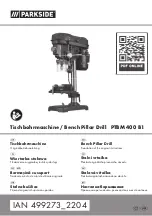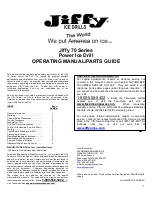
9
Blow-out bulb (optional accessory)
After drilling the hole, use the blow-out bulb to clean the dust
out of the hole.
Drilling operation
CAUTION:
•
Pressing excessively on the tool will not speed up the
drilling. In fact, this excessive pressure will only serve to
damage the tip of your bit, decrease the tool
performance and shorten the service life of the tool.
•
There is a tremendous force exerted on the tool/bit at the
time of hole break through. Hold the tool firmly and exert
care when the bit begins to break through the workpiece.
•
A stuck bit can be removed simply by setting the
reversing switch to reverse rotation in order to back out.
However, the tool may back out abruptly if you do not
hold it firmly.
•
Always secure small workpieces in a vise or similar hold-
down device.
When drilling in wood, metal or plastic materials, turn the
action mode changing knob to the position of
symbol to
use “rotation only” action.
Drilling in wood
When drilling in wood, the best results are obtained with
wood drills equipped with a guide screw. The guide screw
makes drilling easier by pulling the bit into the workpiece.
Drilling in metal
To prevent the bit from slipping when starting a hole, make
an indentation with a center-punch and hammer at the point
to be drilled. Place the point of the bit in the indentation and
start drilling.
Use a cutting lubricant when drilling metals. The exceptions
are iron and brass which should be drilled dry.
1. Blow-out bulb
1
002449


































